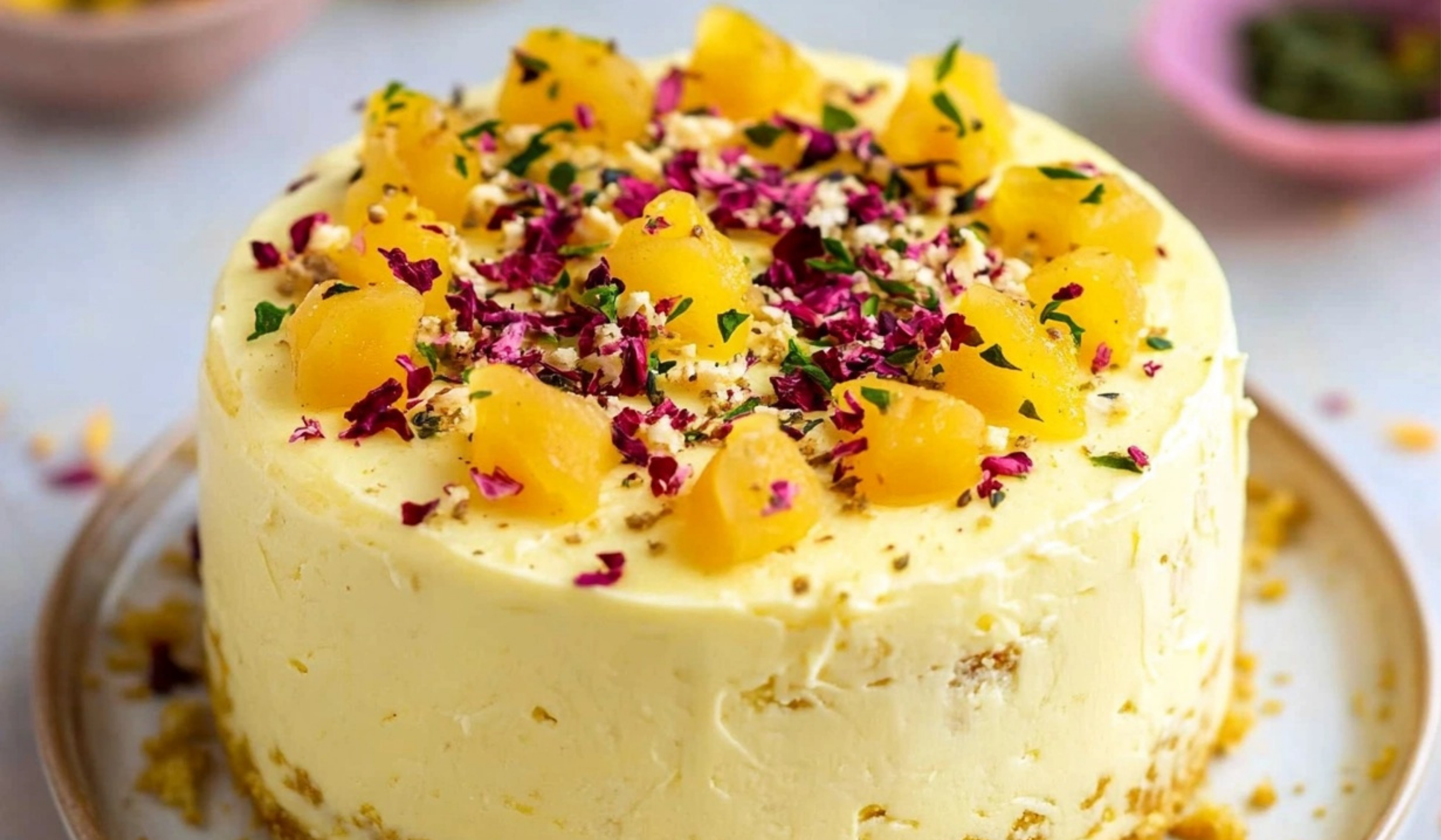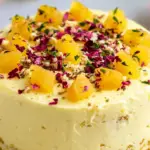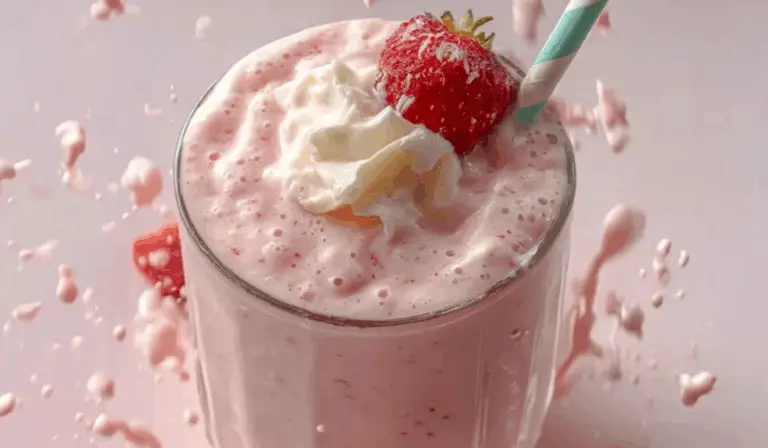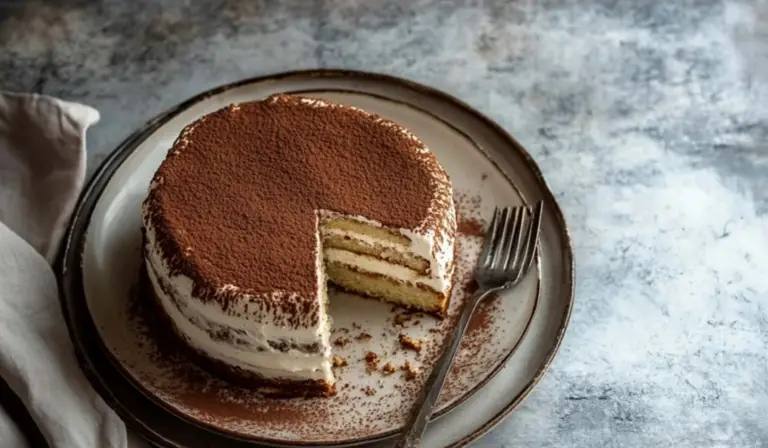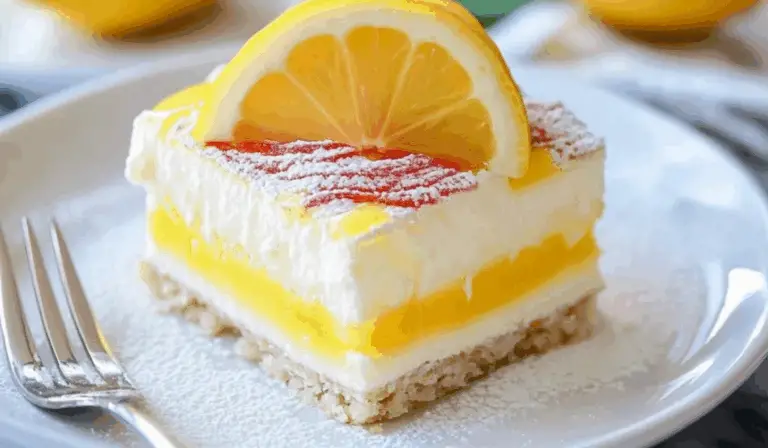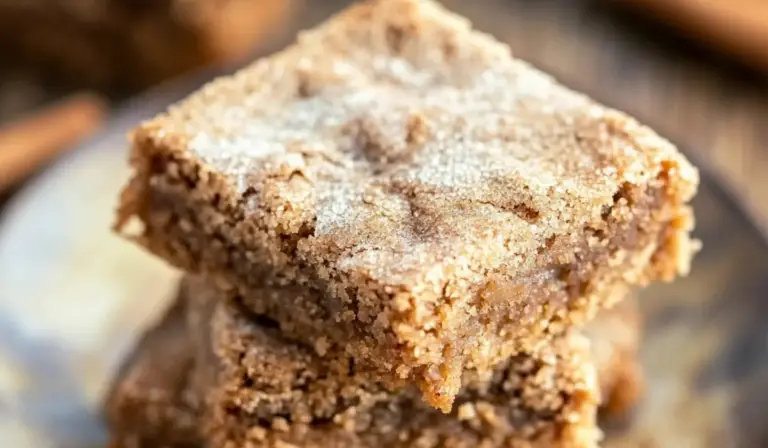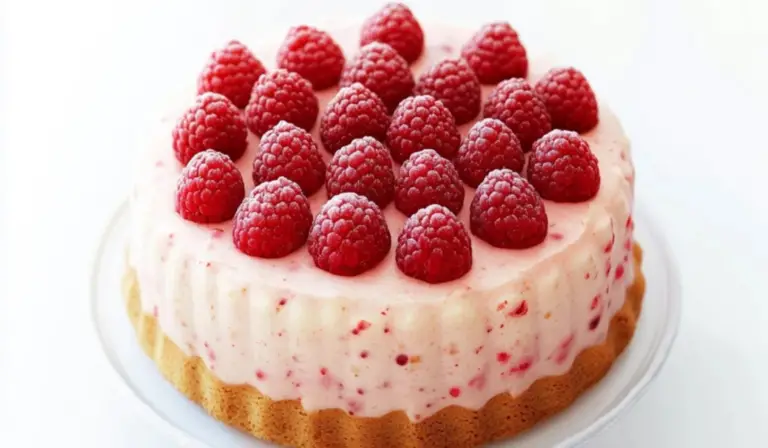Rasmalai Cake: A Delicious Fusion of Indian and Western Flavors
There’s something magical about the marriage of two distinct cultures in a single dish. Rasmalai, an iconic Indian dessert, has a rich history that’s been passed down for generations. It’s made from soft, milk-soaked discs of spongy goodness that seem to melt in your mouth, paired with a sweet, aromatic saffron-infused milk syrup. But what if we could take this dessert and turn it into a cake, combining the best of both worlds? That’s the beauty of Rasmalai Cake: it captures all the flavors of the traditional Rasmalai but in the form of a moist, spongy cake.
PrintRasmalai Cake: A Delicious Fusion of Indian and Western Flavors
Looking for a dessert that combines exotic and comforting? Try Rasmalai Cake! 🍰💛 This fusion cake layers the creamy richness of Rasmalai with the soft, moist texture of cake, creating a dreamy dessert experience. 🧑🍳✨ Perfect for beginners and a crowd-pleaser at any event, it’s a sweet, flavorful treat that blends two culinary worlds into one delicious bite! 🌟🍰
#RasmalaiDelight 🍰💫 #FusionDessertGoals 🇮🇳🍰 #SweetAndCreamy 💛🍴 #BeginnerBaker 👩🍳✨ #ExoticFlavors 🌍🔥 #CakeInnovation 🎂🌟 #IndianDessertTwist 🇮🇳🍬 #DessertPerfection 🍽️💥 #FlavorsOfTheWorld 🌟🌍 #DeliciousFusionTreats 🍰😋
- Prep Time: 20 minutes
- Cook Time: 30 minutes
- Total Time: 50 minutes
- Yield: 8–10 servings 1x
Ingredients
For the Cake:
- 1 ½ cups all-purpose flour
- 1 teaspoon baking powder
- ½ teaspoon baking soda
- 1 pinch of salt
- ½ cup unsalted butter (softened)
- 1 cup sugar (you can use half regular sugar and half brown sugar for a deeper flavor)
- 3 large eggs (room temperature)
- 1 teaspoon vanilla extract
- ¾ cup whole milk (or you can use almond milk for a dairy-free option)
- ¼ cup yogurt (plain, full-fat)
- A pinch of cardamom powder (optional, but adds a lovely fragrance)
For the Rasmalai Syrup:
- 2 cups whole milk (or use full-fat coconut milk for a dairy-free version)
- 1/3 cup sugar (adjust to your preference)
- ½ teaspoon saffron strands (soaked in warm water for 10 minutes)
- 1 teaspoon rose water (optional, for added fragrance)
- 1 teaspoon cardamom powder
For the Decoration:
- 1 cup whipped cream (chilled)
- Sliced almonds and pistachios (for garnish)
- A few extra saffron strands (optional)
Instructions
Step 1: Prepare the Cake Batter
- Preheat your oven to 350°F (175°C). Grease and flour an 8-inch round cake pan or line it with parchment paper for easy removal.
- In a medium bowl, sift together the all-purpose flour, baking powder, baking soda, and salt. Set aside.
- In a large bowl, use an electric mixer or a whisk to cream the softened butter and sugar together until light and fluffy, about 3-4 minutes.
- Add the eggs one at a time, beating well after each addition. Don’t forget to scrape down the sides of the bowl to ensure everything is mixed well.
- Mix in the vanilla extract and yogurt.
- Gradually add the dry ingredients in three parts, alternating with the milk, and mix until smooth. Be careful not to overmix the batter, as this can result in a dense cake.
- If you’re using cardamom powder, fold it into the batter now for an added layer of flavor.
Step 2: Bake the Cake
- Pour the batter into the prepared cake pan and smooth the top with a spatula.
- Bake the cake for 25-30 minutes or until a toothpick inserted in the center comes out clean. Be sure to check at the 25-minute mark, as oven temperatures vary.
- Once baked, allow the cake to cool in the pan for 10 minutes before transferring it to a wire rack to cool completely.
Step 3: Prepare the Rasmalai Syrup
- In a saucepan, combine the whole milk, sugar, saffron, cardamom powder, and rose water (if using). Heat over medium heat, stirring occasionally, until the sugar dissolves completely.
- Let the milk simmer gently for about 10-15 minutes until it thickens slightly, and the saffron’s color infuses the milk.
- Remove from heat and let it cool slightly. The syrup should have a creamy consistency.
Step 4: Soak the Cake
- Once the cake is completely cool, cut it into two or three even layers using a serrated knife.
- Place each layer of the cake onto a plate or cake stand, and slowly pour the warm Rasmalai syrup over the layers. Allow the cake to soak up the syrup—don’t rush this step, as it’s what gives the cake its signature richness.
- If you prefer a stronger flavor, feel free to brush the syrup over the cake layers multiple times.
Step 5: Whip the Cream
- In a chilled mixing bowl, whip the cream until it forms soft peaks. You can add a tablespoon of powdered sugar or vanilla extract for extra sweetness and flavor.
- Once the cream is whipped, spread it generously over the soaked cake layers, smoothing it with a spatula for an even finish.
Step 6: Assemble and Decorate
- Stack the cake layers on top of each other, with the whipped cream in between.
- Cover the entire cake with a smooth layer of whipped cream.
- Garnish with sliced almonds, pistachios, and a few saffron strands for a traditional touch.
Notes
- Baking Tip: Make sure the butter and eggs are at room temperature before you start mixing. This will help the batter come together more smoothly and result in a fluffier cake.
- Soaking Tip: The key to a great Rasmalai Cake is allowing the cake to soak up the syrup. Don’t be afraid to pour the syrup generously, as this is what makes the cake moist and flavorful.
- Troubleshooting Tip: If your cake layers are too dry, try using a little more syrup. If they soak up too much and start falling apart, it may be because the syrup was too warm. Always let the syrup cool slightly before pouring it on the cake.
- Whipping Cream Tip: Make sure your cream is chilled for the best results when whipping. If your cream isn’t thickening, it could be due to the temperature of the cream or overbeating, so watch closely.
As a beginner cook, you might be hesitant to try making this fusion dessert, but don’t worry! This Rasmalai Cake recipe is designed to be simple and approachable, even for first-timers. The cake itself is easy to bake, and the result is an indulgent treat that will impress your friends and family without spending hours in the kitchen. Plus, this recipe uses ingredients that are easy to find, and you don’t need any fancy equipment to create this showstopper dessert.
Why is this recipe perfect for beginners? First, it combines the ease of a basic sponge cake with the richness of Rasmalai’s flavor. You’ll only need a handful of ingredients, and the steps are easy to follow. The best part? The ingredients can be adjusted according to your preferences, so even if you can’t find one item, you’ll have alternatives that will still deliver a fantastic result.
This Rasmalai Cake is also a healthier dessert option compared to many traditional cakes. It uses less sugar and incorporates the goodness of milk, making it a treat that doesn’t compromise on taste while still offering some nutritional value. Let’s dive in and explore how you can make this mouthwatering dessert at home!
Ingredients and Preparation:
For this Rasmalai Cake, you will need the following ingredients:
For the Cake:
- 1 ½ cups all-purpose flour
- 1 teaspoon baking powder
- ½ teaspoon baking soda
- 1 pinch of salt
- ½ cup unsalted butter (softened)
- 1 cup sugar (you can use half regular sugar and half brown sugar for a deeper flavor)
- 3 large eggs (room temperature)
- 1 teaspoon vanilla extract
- ¾ cup whole milk (or you can use almond milk for a dairy-free option)
- ¼ cup yogurt (plain, full-fat)
- A pinch of cardamom powder (optional, but adds a lovely fragrance)
For the Rasmalai Syrup:
- 2 cups whole milk (or use full-fat coconut milk for a dairy-free version)
- 1/3 cup sugar (adjust to your preference)
- ½ teaspoon saffron strands (soaked in warm water for 10 minutes)
- 1 teaspoon rose water (optional, for added fragrance)
- 1 teaspoon cardamom powder
For the Decoration:
- 1 cup whipped cream (chilled)
- Sliced almonds and pistachios (for garnish)
- A few extra saffron strands (optional)
Ingredient Alternatives:
- If you prefer a gluten-free option, you can substitute all-purpose flour with a gluten-free flour blend.
- You can substitute unsalted butter with vegetable oil for a lighter version of the cake.
- If you’re vegan, substitute the eggs with flax eggs or a plant-based egg substitute and use non-dairy milk and yogurt alternatives.
- You can add a bit of condensed milk to the syrup for extra richness, but keep in mind that this will make the dessert sweeter.
- For a more intense flavor, add a splash of kewra water (a fragrant floral essence commonly used in Indian sweets) along with the rose water.
Step-by-Step Instructions:
Now, let’s walk through the process of creating this Rasmalai Cake. Don’t be intimidated by the steps—it’s quite straightforward, and the result will be so worth it!
Step 1: Prepare the Cake Batter
- Preheat your oven to 350°F (175°C). Grease and flour an 8-inch round cake pan or line it with parchment paper for easy removal.
- In a medium bowl, sift together the all-purpose flour, baking powder, baking soda, and salt. Set aside.
- In a large bowl, use an electric mixer or a whisk to cream the softened butter and sugar together until light and fluffy, about 3-4 minutes.
- Add the eggs one at a time, beating well after each addition. Don’t forget to scrape down the sides of the bowl to ensure everything is mixed well.
- Mix in the vanilla extract and yogurt.
- Gradually add the dry ingredients in three parts, alternating with the milk, and mix until smooth. Be careful not to overmix the batter, as this can result in a dense cake.
- If you’re using cardamom powder, fold it into the batter now for an added layer of flavor.
Step 2: Bake the Cake
- Pour the batter into the prepared cake pan and smooth the top with a spatula.
- Bake the cake for 25-30 minutes or until a toothpick inserted in the center comes out clean. Be sure to check at the 25-minute mark, as oven temperatures vary.
- Once baked, allow the cake to cool in the pan for 10 minutes before transferring it to a wire rack to cool completely.
Step 3: Prepare the Rasmalai Syrup
- In a saucepan, combine the whole milk, sugar, saffron, cardamom powder, and rose water (if using). Heat over medium heat, stirring occasionally, until the sugar dissolves completely.
- Let the milk simmer gently for about 10-15 minutes until it thickens slightly, and the saffron’s color infuses the milk.
- Remove from heat and let it cool slightly. The syrup should have a creamy consistency.
Step 4: Soak the Cake
- Once the cake is completely cool, cut it into two or three even layers using a serrated knife.
- Place each layer of the cake onto a plate or cake stand, and slowly pour the warm Rasmalai syrup over the layers. Allow the cake to soak up the syrup—don’t rush this step, as it’s what gives the cake its signature richness.
- If you prefer a stronger flavor, feel free to brush the syrup over the cake layers multiple times.
Step 5: Whip the Cream
- In a chilled mixing bowl, whip the cream until it forms soft peaks. You can add a tablespoon of powdered sugar or vanilla extract for extra sweetness and flavor.
- Once the cream is whipped, spread it generously over the soaked cake layers, smoothing it with a spatula for an even finish.
Step 6: Assemble and Decorate
- Stack the cake layers on top of each other, with the whipped cream in between.
- Cover the entire cake with a smooth layer of whipped cream.
- Garnish with sliced almonds, pistachios, and a few saffron strands for a traditional touch.
Beginner Tips and Notes:
- Baking Tip: Make sure the butter and eggs are at room temperature before you start mixing. This will help the batter come together more smoothly and result in a fluffier cake.
- Soaking Tip: The key to a great Rasmalai Cake is allowing the cake to soak up the syrup. Don’t be afraid to pour the syrup generously, as this is what makes the cake moist and flavorful.
- Troubleshooting Tip: If your cake layers are too dry, try using a little more syrup. If they soak up too much and start falling apart, it may be because the syrup was too warm. Always let the syrup cool slightly before pouring it on the cake.
- Whipping Cream Tip: Make sure your cream is chilled for the best results when whipping. If your cream isn’t thickening, it could be due to the temperature of the cream or overbeating, so watch closely.
Serving Suggestions:
- Serve this Rasmalai Cake with a chilled glass of chai or your favorite Indian beverage.
- If you want to make it extra indulgent, pair it with a scoop of vanilla ice cream or a dollop of clotted cream.
- The cake can also be served with fresh fruit like berries or mango slices for a refreshing contrast.

Storage Tips:
- Store any leftover cake in an airtight container in the fridge for up to 3 days. The cake will continue to soak up the syrup, making it even more delicious on the second day!
- If you want to freeze the cake, wrap it tightly in plastic wrap and foil, then freeze for up to 1 month. Thaw it in the fridge before serving.
Conclusion:
And there you have it—a gorgeous, indulgent Rasmalai Cake that’s perfect for any special occasion or even just a sweet treat after dinner. I hope this recipe has inspired you to try making your own version of this fusion dessert. Whether you’re a beginner cook or a seasoned pro, you’ll find that this cake is easier to make than you might think, and the results are absolutely worth it.
Give this recipe a try and let us know how it turned out for you in the comments. We’d love to hear about your experience and any tweaks you made to make the cake your own. Happy baking!

